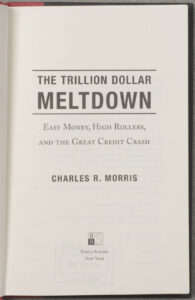Published: New York, 2008
Early in 2007, Charles Morris emailed his publisher. “I think we’re heading for the mother of all crashes,” he wrote. “It will happen in summer of 2008, I think.” At the same time, our nation’s financial leaders, both in Washington and on Wall Street, were telling Congress  that the U.S. economy was in beautiful shape. Unfortunately, it was Morris who turned out to be right.
that the U.S. economy was in beautiful shape. Unfortunately, it was Morris who turned out to be right.
In his foreword, the author treats us to a simplified account of the credit bubble. “Not long ago,” he writes, “the sum of all financial assets – stocks, bonds, loans, mortgages, and the like, which are claims on real things – were about equal to global GDP. Now they are approaching four times global GDP.” He likens this situation to an inverted pyramid, which becomes more wobbly as you pile on more claims. “And when large, wobbly objects tumble, they go very fast.”
In this volume deemed a Notable Book of the Year by The New York Times and a Best Book of 2008 by The Economist, Morris explains for the layman, in crystal clear prose, what got us into this Great Recession. Or maybe we should say what Morris predicted would cause this Great Recession, since he wrote much of the book before the market crashed.
Morris himself is a former lawyer and banker. In fact, he ran a company that built the software that enabled bankers to create the sophisticated credit instruments that landed us in this mess. He was dismayed by what bankers were doing with his software. “This is crazy,” he said in a 2008 interview with NPR. “I was sure that people weren’t keeping track of the trends so they had proper margins and collateral and so forth.” The credit instruments were too complex and the volume of trading too high to realistically gauge the risk. The inverted pyramid eventually tumbled.
There is hope, Morris claims, but only with increased regulation of the financial markets. And only if American consumers, too, can curb their tendencies to spend with so much borrowed cash.
